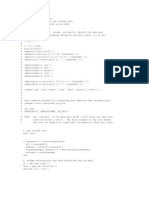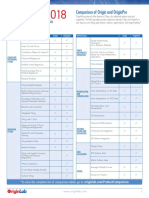Fspecial
Fspecial
Uploaded by
Ahmad BasCopyright:
Available Formats
Fspecial
Fspecial
Uploaded by
Ahmad BasOriginal Title
Copyright
Available Formats
Share this document
Did you find this document useful?
Is this content inappropriate?
Copyright:
Available Formats
Fspecial
Fspecial
Uploaded by
Ahmad BasCopyright:
Available Formats
1/9/12 11:21 AM
C:\MATLAB7\toolbox\images\images\fspecial.m
1 of 7
function h = fspecial(varargin) %FSPECIAL Create 2-D special filters. % H = FSPECIAL(TYPE) creates a two-dimensional filter H of the % specified type. Possible values for TYPE are: % % 'average' averaging filter % 'disk' circular averaging filter % 'gaussian' Gaussian lowpass filter % 'laplacian' filter approximating the 2-D Laplacian operator % 'log' Laplacian of Gaussian filter % 'motion' motion filter % 'prewitt' Prewitt horizontal edge-emphasizing filter % 'sobel' Sobel horizontal edge-emphasizing filter % 'unsharp' unsharp contrast enhancement filter % % Depending on TYPE, FSPECIAL may take additional parameters % which you can supply. These parameters all have default % values. % % H = FSPECIAL('average',HSIZE) returns an averaging filter H of size % HSIZE. HSIZE can be a vector specifying the number of rows and columns in % H or a scalar, in which case H is a square matrix. % The default HSIZE is [3 3]. % % H = FSPECIAL('disk',RADIUS) returns a circular averaging filter % (pillbox) within the square matrix of side 2*RADIUS+1. % The default RADIUS is 5. % % H = FSPECIAL('gaussian',HSIZE,SIGMA) returns a rotationally % symmetric Gaussian lowpass filter of size HSIZE with standard % deviation SIGMA (positive). HSIZE can be a vector specifying the % number of rows and columns in H or a scalar, in which case H is a % square matrix. % The default HSIZE is [3 3], the default SIGMA is 0.5. % % H = FSPECIAL('laplacian',ALPHA) returns a 3-by-3 filter % approximating the shape of the two-dimensional Laplacian % operator. The parameter ALPHA controls the shape of the % Laplacian and must be in the range 0.0 to 1.0. % The default ALPHA is 0.2. % % H = FSPECIAL('log',HSIZE,SIGMA) returns a rotationally symmetric % Laplacian of Gaussian filter of size HSIZE with standard deviation % SIGMA (positive). HSIZE can be a vector specifying the number of rows % and columns in H or a scalar, in which case H is a square matrix. % The default HSIZE is [5 5], the default SIGMA is 0.5. % % H = FSPECIAL('motion',LEN,THETA) returns a filter to approximate, once % convolved with an image, the linear motion of a camera by LEN pixels, % with an angle of THETA degrees in a counter-clockwise direction. The % filter becomes a vector for horizontal and vertical motions. The % default LEN is 9, the default THETA is 0, which corresponds to a
1/9/12 11:21 AM % % % % % % % % % % % % % % % % % % % % % % % % % % % % % % % % % % % % % % % % % %
C:\MATLAB7\toolbox\images\images\fspecial.m
2 of 7
horizontal motion of 9 pixels. H = FSPECIAL('prewitt') returns 3-by-3 filter that emphasizes horizontal edges by approximating a vertical gradient. If you need to emphasize vertical edges, transpose the filter H: H'. [1 1 1;0 0 0;-1 -1 -1]. H = FSPECIAL('sobel') returns 3-by-3 filter that emphasizes horizontal edges utilizing the smoothing effect by approximating a vertical gradient. If you need to emphasize vertical edges, transpose the filter H: H'. [1 2 1;0 0 0;-1 -2 -1]. H = FSPECIAL('unsharp',ALPHA) returns a 3-by-3 unsharp contrast enhancement filter. FSPECIAL creates the unsharp filter from the negative of the Laplacian filter with parameter ALPHA. ALPHA controls the shape of the Laplacian and must be in the range 0.0 to 1.0. The default ALPHA is 0.2. Class Support ------------H is of class double. Example ------I = imread('cameraman.tif'); subplot(2,2,1);imshow(I);title('Original Image'); H = fspecial('motion',20,45); MotionBlur = imfilter(I,H,'replicate'); subplot(2,2,2);imshow(MotionBlur);title('Motion Blurred Image'); H = fspecial('disk',10); blurred = imfilter(I,H,'replicate'); subplot(2,2,3);imshow(blurred);title('Blurred Image'); H = fspecial('unsharp'); sharpened = imfilter(I,H,'replicate'); subplot(2,2,4);imshow(sharpened);title('Sharpened Image'); See also CONV2, EDGE, FILTER2, FSAMP2, FWIND1, FWIND2, IMFILTER. Copyright 1993-2003 The MathWorks, Inc. $Revision: 5.28.4.2 $ $Date: 2003/01/26 05:55:24 $
[type, p2, p3] = ParseInputs(varargin{:}); switch type case 'average' % Smoothing filter siz = p2; h = ones(siz)/prod(siz); case 'disk' % Disk filter
1/9/12 11:21 AM
C:\MATLAB7\toolbox\images\images\fspecial.m
3 of 7
rad = p2; crad = ceil(rad-0.5); [x,y] = meshgrid(-crad:crad,-crad:crad); maxxy = max(abs(x),abs(y)); minxy = min(abs(x),abs(y)); m1 = (rad^2 < (maxxy+0.5).^2 + (minxy-0.5).^2).*(minxy-0.5) + ... (rad^2 >= (maxxy+0.5).^2 + (minxy-0.5).^2).* ... sqrt(rad^2 - (maxxy + 0.5).^2); m2 = (rad^2 > (maxxy-0.5).^2 + (minxy+0.5).^2).*(minxy+0.5) + ... (rad^2 <= (maxxy-0.5).^2 + (minxy+0.5).^2).* ... sqrt(rad^2 - (maxxy - 0.5).^2); sgrid = (rad^2*(0.5*(asin(m2/rad) - asin(m1/rad)) + ... 0.25*(sin(2*asin(m2/rad)) - sin(2*asin(m1/rad)))) - ... (maxxy-0.5).*(m2-m1) + (m1-minxy+0.5)) ... .*((((rad^2 < (maxxy+0.5).^2 + (minxy+0.5).^2) & ... (rad^2 > (maxxy-0.5).^2 + (minxy-0.5).^2)) | ... ((minxy==0)&(maxxy-0.5 < rad)&(maxxy+0.5>=rad)))); sgrid = sgrid + ((maxxy+0.5).^2 + (minxy+0.5).^2 < rad^2); sgrid(crad+1,crad+1) = min(pi*rad^2,pi/2); if ((crad>0) & (rad > crad-0.5) & (rad^2 < (crad-0.5)^2+0.25)) m1 = sqrt(rad^2 - (crad - 0.5).^2); m1n = m1/rad; sg0 = 2*(rad^2*(0.5*asin(m1n) + 0.25*sin(2*asin(m1n)))-m1*(crad-0.5)); sgrid(2*crad+1,crad+1) = sg0; sgrid(crad+1,2*crad+1) = sg0; sgrid(crad+1,1) = sg0; sgrid(1,crad+1) = sg0; sgrid(2*crad,crad+1) = sgrid(2*crad,crad+1) - sg0; sgrid(crad+1,2*crad) = sgrid(crad+1,2*crad) - sg0; sgrid(crad+1,2) = sgrid(crad+1,2) - sg0; sgrid(2,crad+1) = sgrid(2,crad+1) - sg0; end sgrid(crad+1,crad+1) = min(sgrid(crad+1,crad+1),1); h = sgrid/sum(sgrid(:)); case 'gaussian' % Gaussian filter siz std = (p2-1)/2; = p3;
[x,y] = meshgrid(-siz(2):siz(2),-siz(1):siz(1)); arg = -(x.*x + y.*y)/(2*std*std); h = exp(arg); h(h<eps*max(h(:))) = 0; sumh = sum(h(:)); if sumh ~= 0, h = h/sumh; end ; case 'laplacian' % Laplacian filter
1/9/12 11:21 AM alpha alpha h1 h = = = =
C:\MATLAB7\toolbox\images\images\fspecial.m
4 of 7
p2; max(0,min(alpha,1)); alpha/(alpha+1); h2 = (1-alpha)/(alpha+1); [h1 h2 h1;h2 -4/(alpha+1) h2;h1 h2 h1];
case 'log' % Laplacian of Gaussian % first calculate Gaussian siz = (p2-1)/2; std2 = p3^2; [x,y] = meshgrid(-siz(2):siz(2),-siz(1):siz(1)); arg = -(x.*x + y.*y)/(2*std2); h = exp(arg); h(h<eps*max(h(:))) = 0; sumh = sum(h(:)); if sumh ~= 0, h = h/sumh; end ; % now calculate Laplacian h1 = h.*(x.*x + y.*y - 2*std2)/(std2^2); h = h1 - sum(h1(:))/prod(p2); % make the filter sum to zero case 'motion' % Motion filter uses bilinear interpolation len = max(1,p2); half = (len-1)/2; % rotate half length around center phi = mod(p3,180)/180*pi; cosphi = cos(phi); sinphi = sin(phi); xsign = sign(cosphi); linewdt = 1; % define mesh for the half matrix, eps takes care of the right size % for 0 & 90 rotation sx = fix(half*cosphi + linewdt*xsign - len*eps); sy = fix(half*sinphi + linewdt - len*eps); [x y] = meshgrid([0:xsign:sx],[0:sy]); % define shortest distance from a pixel to the rotated line dist2line = (y*cosphi-x*sinphi); % distance perpendicular to the line rad = sqrt(x.^2 + y.^2); % find points beyond the line's end-point but within the line width lastpix = find((rad >= half)&(abs(dist2line)<=linewdt)); %distance to the line's end-point parallel to the line x2lastpix = half - abs((x(lastpix) + dist2line(lastpix)*sinphi)/cosphi); dist2line(lastpix) = sqrt(dist2line(lastpix).^2 + x2lastpix.^2); dist2line = linewdt + eps - abs(dist2line); dist2line(dist2line<0) = 0; % zero out anything beyond line width
1/9/12 11:21 AM
C:\MATLAB7\toolbox\images\images\fspecial.m
5 of 7
% unfold half-matrix to the full size h = rot90(dist2line,2); h(end+[1:end]-1,end+[1:end]-1) = dist2line; h = h./(sum(h(:)) + eps*len*len); if cosphi>0, h = flipud(h); end case 'prewitt' % Prewitt filter h = [1 1 1;0 0 0;-1 -1 -1]; case 'sobel' % Sobel filter h = [1 2 1;0 0 0;-1 -2 -1]; case 'unsharp' % Unsharp filter alpha = p2; h = [0 0 0;0 1 0;0 0 0] - fspecial( 'laplacian' ,alpha); end
%%% %%% ParseInputs %%% function [type, p2, p3] = ParseInputs(varargin) % default type p2 p3 values = '' ; = []; = [];
% Check the number of input arguments. checknargin(1,3,nargin,mfilename); % Determine filter type from the user supplied string. type = varargin{1}; type = checkstrs(type,{ 'gaussian' ,'sobel' ,'prewitt' , 'laplacian' , 'log', ... 'average' , 'unsharp', 'disk' ,'motion' },mfilename, 'TYPE' ,1); % default values switch type case 'average' p2 = [3 3]; % siz case 'disk' p2 = 5;
% rad
case 'gaussian' p2 = [3 3]; % siz p3 = 0.5; % std
1/9/12 11:21 AM
C:\MATLAB7\toolbox\images\images\fspecial.m
6 of 7
case {'laplacian' , 'unsharp' } p2 = 1/5; % alpha case 'log' p2 = [5 5]; p3 = 0.5;
% siz % std
case 'motion' p2 = 9; % len p3 = 0; % theta end
switch nargin case 1 % FSPECIAL('average') % FSPECIAL('disk') % FSPECIAL('gaussian') % FSPECIAL('laplacian') % FSPECIAL('log') % FSPECIAL('motion') % FSPECIAL('prewitt') % FSPECIAL('sobel') % FSPECIAL('unsharp') % Nothing to do here; the default values have % already been assigned. case 2 % FSPECIAL('average',N) % FSPECIAL('disk',RADIUS) % FSPECIAL('gaussian',N) % FSPECIAL('laplacian',ALPHA) % FSPECIAL('log',N) % FSPECIAL('motion',LEN) % FSPECIAL('unsharp',ALPHA) p2 = varargin{2}; switch type case { 'sobel' , 'prewitt' } msg = sprintf( '%s: Too many arguments for this type of filter.' , upper (mfilename)); eid = sprintf( 'Images:%s:tooManyArgsForThisFilter' , mfilename); error(eid,msg); case { 'laplacian' , 'unsharp' } checkinput(p2,{ 'double' },{ 'nonnegative' , 'real' , ... 'nonempty', 'finite' , 'scalar' }, ... mfilename, 'ALPHA' ,2); if p2 > 1 msg = sprintf( '%s: ALPHA should be less than or equal 1 and greater than 0.', upper(mfilename)); eid = sprintf( 'Images:%s:outOfRangeAlpha' , mfilename);
1/9/12 11:21 AM
C:\MATLAB7\toolbox\images\images\fspecial.m
7 of 7
error(eid,msg); end case { 'disk' , 'motion' } checkinput(p2,{ 'double' },{ 'positive','finite' , 'real' ,'nonempty' , 'scalar' }, mfilename,'RADIUS or LEN' ,2); case { 'gaussian', 'log' , 'average'} checkinput(p2,{ 'double' },{ 'positive','finite' , 'real' ,'nonempty' , 'integer' }, mfilename,'HSIZE' ,2); if prod(size(p2)) > 2 msg = 'HSIZE should have 1 or 2 elements.' ; eid = sprintf( 'Images:%s:wrongSizeN' , mfilename); error(eid,msg); elseif (prod(size(p2))==1) p2 = [p2 p2]; end end
case 3 % FSPECIAL('gaussian',N,SIGMA) % FSPECIAL('log',N,SIGMA) % FSPECIAL('motion',LEN,THETA) p2 = varargin{2}; p3 = varargin{3}; switch type case 'motion' checkinput(p2,{ 'double' },{ 'positive','finite' , 'real' ,'nonempty' , 'scalar' }, mfilename,'LEN' ,2); checkinput(p3,{ 'double' },{ 'real' , 'nonempty' , 'finite' ,'scalar' }, mfilename,'THETA' ,3); case { 'gaussian', 'log' } checkinput(p2,{ 'double' },{ 'positive','finite' , 'real' ,'nonempty' , 'integer' }, mfilename,'N' ,2); checkinput(p3,{ 'double' },{ 'positive','finite' , 'real' ,'nonempty' , 'scalar' }, mfilename,'SIGMA' ,3); if prod(size(p2)) > 2 msg = sprintf( '%s: size(N) should be less than or equal 2.' , upper (mfilename)); eid = sprintf( 'Images:%s:wrongSizeN' , mfilename); error(eid,msg); elseif (prod(size(p2))==1) p2 = [p2 p2]; end otherwise msg = sprintf( '%s: Too many arguments for this type of filter.' , upper (mfilename)); eid = sprintf( 'Images:%s:tooManyArgsForThisFilter' , mfilename); error(eid,msg); end end
You might also like
- Unit Commitment PDFDocument37 pagesUnit Commitment PDFdubstepo100% (3)
- An Introduction To Ordinary Differential Equations M Files: AtlabDocument37 pagesAn Introduction To Ordinary Differential Equations M Files: AtlabhasanmasoudiNo ratings yet
- CchelpDocument119 pagesCchelpLaco tangara JhuniorNo ratings yet
- Matlab Practice DSP LabDocument10 pagesMatlab Practice DSP LabPrudhvi MunagalaNo ratings yet
- Function AddaxisDocument12 pagesFunction AddaxisAyrton Estrada SotoNo ratings yet
- S DixitDocument57 pagesS DixitRushi GoreNo ratings yet
- Inertial Sensor Noise Analysis Using Allan Variance - MATLAB & SimulinkDocument10 pagesInertial Sensor Noise Analysis Using Allan Variance - MATLAB & SimulinkParasaram SrinivasNo ratings yet
- CappstoneDocument2 pagesCappstoneAnkita MishraNo ratings yet
- Matlab BasicDocument20 pagesMatlab BasicAbdulloh AsatullayevNo ratings yet
- MATLAB Command Window: FisheririsDocument9 pagesMATLAB Command Window: FisheririsAbyan JadidanNo ratings yet
- PrettyFFT MDocument5 pagesPrettyFFT MThomas GeorgeNo ratings yet
- Matlab RBFDocument5 pagesMatlab RBFmallikarjunabalimidiNo ratings yet
- Name:Ishwor Acharya Rollno: 076MSMDE008 Matlab Code For Non-Lifting Cylinder Velocity PotentialDocument6 pagesName:Ishwor Acharya Rollno: 076MSMDE008 Matlab Code For Non-Lifting Cylinder Velocity PotentialishworNo ratings yet
- Xmas Tree in MATLABDocument8 pagesXmas Tree in MATLABMirzaNo ratings yet
- LMSPDocument7 pagesLMSPPesta SigalinggingNo ratings yet
- Mywarp CodeDocument3 pagesMywarp Codeapi-252349230No ratings yet
- Kumpulan Iterasi MATLABDocument10 pagesKumpulan Iterasi MATLABZia SilverNo ratings yet
- Lab 6 Matlab Channel Modelling RayleighDocument8 pagesLab 6 Matlab Channel Modelling RayleighadvikapriyaNo ratings yet
- Chapter 8 Design of Infinite Impulse Response (IIR) Digital FiltersDocument9 pagesChapter 8 Design of Infinite Impulse Response (IIR) Digital FiltersJean Danny PhiliusNo ratings yet
- Kilian 2009 CodeDocument25 pagesKilian 2009 CodeJongkol NaenonNo ratings yet
- Name: Masood Salik BSEE-14-18 Convergence / Existence of DTFT and Gibbs PhenomenonDocument5 pagesName: Masood Salik BSEE-14-18 Convergence / Existence of DTFT and Gibbs PhenomenonAmina TabassumNo ratings yet
- Exercise5 RodneyMuganziDocument11 pagesExercise5 RodneyMuganzimugrodnyNo ratings yet
- Assignment No 8Document17 pagesAssignment No 8264 HAMNA AMIRNo ratings yet
- Sci ManualDocument649 pagesSci ManualJeanMichelMNo ratings yet
- BB + LC + RKE BUY SELL Indicator Revised 2Document9 pagesBB + LC + RKE BUY SELL Indicator Revised 2olympioNo ratings yet
- Matrices MatlabDocument4 pagesMatrices MatlabUIGNo ratings yet
- Maxima Class Notes: 2.1 Save Time 2.2 Simple UI 2.3 Less RestrictionsDocument10 pagesMaxima Class Notes: 2.1 Save Time 2.2 Simple UI 2.3 Less RestrictionsAkshitNo ratings yet
- Module 2 Lab Activity - RegressionDocument9 pagesModule 2 Lab Activity - RegressionjulienneulitNo ratings yet
- Lab Report - Dynamical SystemsDocument14 pagesLab Report - Dynamical SystemsAnonymous rGiBhi0% (1)
- Distributions DemoDocument28 pagesDistributions Demosid immanualNo ratings yet
- Matlab Script FileDocument8 pagesMatlab Script Filetvr123No ratings yet
- Homework 2Document14 pagesHomework 2Anette Wendy Quipo KanchaNo ratings yet
- Function: 'Buffalo (I,:) BP - K (I) 'Document5 pagesFunction: 'Buffalo (I,:) BP - K (I) 'Atul NarkhedeNo ratings yet
- BB + LC + RKE BUY SELL Indicator Revised 3 FinalDocument9 pagesBB + LC + RKE BUY SELL Indicator Revised 3 FinalolympioNo ratings yet
- LampiranDocument11 pagesLampiranansar rizalNo ratings yet
- MatlabDocument59 pagesMatlabReda BekhakhechaNo ratings yet
- Matlab TipsDocument14 pagesMatlab Tipsfilip100No ratings yet
- Bode PaperDocument2 pagesBode Papermrufino18No ratings yet
- Genetic AlgorithmDocument6 pagesGenetic AlgorithmShashikant ChaurasiaNo ratings yet
- New 1Document17 pagesNew 1Nafisa IslamNo ratings yet
- FernDocument8 pagesFerniesaaaNo ratings yet
- 05 Matlab and Roots IVDocument20 pages05 Matlab and Roots IVHamza MahmoodNo ratings yet
- MATLABDocument6 pagesMATLABAmar DizdarNo ratings yet
- Mina M. Nath-1Document18 pagesMina M. Nath-1Mina NathNo ratings yet
- Secant MethodDocument5 pagesSecant MethodLn Amitav BiswasNo ratings yet
- Complete CalculusDocument17 pagesComplete CalculusTutul MalakarNo ratings yet
- Matlab Fundamentals: Computer-Aided ManufacturingDocument47 pagesMatlab Fundamentals: Computer-Aided ManufacturingAyub PadaniaNo ratings yet
- Question 1Document3 pagesQuestion 1Lakshmi SampathNo ratings yet
- Lyapunov 1Document4 pagesLyapunov 1Wawerudas100% (1)
- Matlab Image HintDocument23 pagesMatlab Image Hintsidharthipalanisamy100% (1)
- CH Density EstimationDocument15 pagesCH Density EstimationLovekesh ThakurNo ratings yet
- With Code (New Updates) February 5, 2010 Citation ,: Print Article XML AilDocument16 pagesWith Code (New Updates) February 5, 2010 Citation ,: Print Article XML AilsidharthipalanisamyNo ratings yet
- Soft Computing Lab LabsDocument8 pagesSoft Computing Lab Labsnegigaurav009No ratings yet
- Lab 1: Introduction To Matlab Engr 451: Zachary Armendariz and Luke JocsonDocument7 pagesLab 1: Introduction To Matlab Engr 451: Zachary Armendariz and Luke JocsonkevinNo ratings yet
- مشروع عبدالرحمن +زيدDocument15 pagesمشروع عبدالرحمن +زيدAbdulrahman AlsalawiNo ratings yet
- Successive OverDocument5 pagesSuccessive OverYohannesNo ratings yet
- Matlab CodeDocument3 pagesMatlab CodePrince PavanNo ratings yet
- CODEDocument6 pagesCODEZahid NadeemNo ratings yet
- APPENDIX F - Matlab Code Used To Determine Extrapolation FactorDocument12 pagesAPPENDIX F - Matlab Code Used To Determine Extrapolation FactorMartina Marinković PlehatiNo ratings yet
- Nonlinear Control Feedback Linearization Sliding Mode ControlFrom EverandNonlinear Control Feedback Linearization Sliding Mode ControlNo ratings yet
- StrelDocument17 pagesStrelAhmad BasNo ratings yet
- ImreadDocument8 pagesImreadAhmad BasNo ratings yet
- ImshowDocument11 pagesImshowAhmad BasNo ratings yet
- ImfilterDocument7 pagesImfilterAhmad BasNo ratings yet
- De Conv BlindDocument9 pagesDe Conv BlindAhmad BasNo ratings yet
- Isolating Components Uav VibrationDocument12 pagesIsolating Components Uav VibrationAhmad BasNo ratings yet
- Isolating Components Uav VibrationDocument12 pagesIsolating Components Uav VibrationAhmad BasNo ratings yet
- DLL Mathematics 3 q3 w5Document4 pagesDLL Mathematics 3 q3 w5Daniel Angelo TiongsonNo ratings yet
- MathsDocument10 pagesMathsangelrasNo ratings yet
- CH 06 Sensitivity Analysis and DualityDocument32 pagesCH 06 Sensitivity Analysis and DualityOky TresiaNo ratings yet
- FREE Soroban Abacus Maths Secret Workbook PDFDocument74 pagesFREE Soroban Abacus Maths Secret Workbook PDFTatyana Sukhomlinova100% (3)
- Stewart DerivativesDocument28 pagesStewart DerivativesAroosha KhanNo ratings yet
- Formative Trig. SchemeDocument10 pagesFormative Trig. Schemefarida SaaniNo ratings yet
- The Lorenz System: James HateleyDocument25 pagesThe Lorenz System: James HateleyTapomoy Guha SarkarNo ratings yet
- GMAT Quant Topic 6 Co-Ordinate Geometry SolutionsDocument20 pagesGMAT Quant Topic 6 Co-Ordinate Geometry SolutionsRushabh VoraNo ratings yet
- Probability and Statistic Chapter4Document58 pagesProbability and Statistic Chapter4PHƯƠNG ĐẶNG YẾNNo ratings yet
- Ameya World School, Sangivalasa, Visakhapatnam Summative Assessment-Ii (2020-21)Document9 pagesAmeya World School, Sangivalasa, Visakhapatnam Summative Assessment-Ii (2020-21)KRISHNA SUSHRUT ANo ratings yet
- Math IvDocument11 pagesMath IvMarinelle CabuhalNo ratings yet
- Chapter 3 GATE QuestionsDocument2 pagesChapter 3 GATE Questionsdeviv94340No ratings yet
- Of Delhi: Name Roll NoDocument3 pagesOf Delhi: Name Roll NoChitsimran Singh AroraNo ratings yet
- Ass2 Ans KeyDocument10 pagesAss2 Ans KeyDENIEL MIKE DUKANo ratings yet
- DLL-Math 9 Quarter 1week 2 SY 2023-2024Document9 pagesDLL-Math 9 Quarter 1week 2 SY 2023-2024rhea diadulaNo ratings yet
- Codechef Practice ProblemsDocument7 pagesCodechef Practice ProblemsgyugamNo ratings yet
- C Algorithms For Real-Time DSP - EMBREEDocument125 pagesC Algorithms For Real-Time DSP - EMBREELuiz Carlos da SilvaNo ratings yet
- Matlab Cheat Sheet PDFDocument3 pagesMatlab Cheat Sheet PDFKarishmaNo ratings yet
- Maths EMDocument7 pagesMaths EMSubramanyam K.V.RNo ratings yet
- 5@ Test Properties of NumbersDocument6 pages5@ Test Properties of Numberssvenkatk737100% (1)
- CGL 2022 Chapter-Wise Mock Img RBE CompressedDocument132 pagesCGL 2022 Chapter-Wise Mock Img RBE Compressedchirag bawejaNo ratings yet
- Curriculum Map Math-10-2nd-QuarterDocument4 pagesCurriculum Map Math-10-2nd-QuarterDaniel Javier (Dans)100% (1)
- Preli Math (English) Topic Based Selected Questions - Rahat M HuqDocument54 pagesPreli Math (English) Topic Based Selected Questions - Rahat M HuqAvijit MandalNo ratings yet
- Origin Vs OriginPro 2018Document3 pagesOrigin Vs OriginPro 2018ÄhmêdÄBdulhåqNo ratings yet
- Palawan State University - BS Petroleum Engineering CurriculumDocument3 pagesPalawan State University - BS Petroleum Engineering CurriculumPaolo SalvatierraNo ratings yet
- Class 11 Complex Number Solutions DPP 1Document10 pagesClass 11 Complex Number Solutions DPP 1nabhijain9No ratings yet
- Solution Course in Finite Element Fish BingDocument5 pagesSolution Course in Finite Element Fish Binggita nahdhaliaNo ratings yet
- Balaji Opt Lecture8 ActDocument72 pagesBalaji Opt Lecture8 ActHalwa KhoiriNo ratings yet






























































































